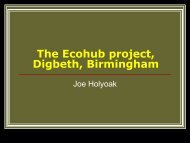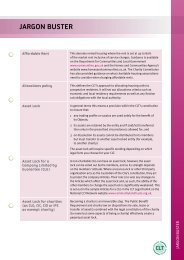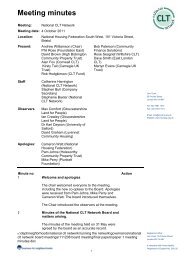Then we will do it ourselves - Community Land Trusts
Then we will do it ourselves - Community Land Trusts
Then we will do it ourselves - Community Land Trusts
You also want an ePaper? Increase the reach of your titles
YUMPU automatically turns print PDFs into web optimized ePapers that Google loves.
... foundation stone for othercommun<strong>it</strong>y activ<strong>it</strong>iesCommun<strong>it</strong>y-led involvementAt a pol<strong>it</strong>ical level, all three major parties at Westminster haveadvocated the need for commun<strong>it</strong>ies to take action to solve localproblems. By defin<strong>it</strong>ion CLT schemes can achieve rural homes torent/disposal by shared equ<strong>it</strong>y that are supplementary to those providedby housing associations; they can also be the foundation stone for othercommun<strong>it</strong>y activ<strong>it</strong>ies. The challenges to achieving replication of thepioneering schemes listed in the previous paragraph and start to achievescale fall under five main headings:-(a) Commun<strong>it</strong>y entrepreneursCLTs are currently being established on an ad-hoc basis but a commoningredient is lay-led leadership by local people who are comm<strong>it</strong>ted tomaking a difference in their commun<strong>it</strong>y. To succeed, they need to begiven practical support and encouraged to overcome the obstacles that,inev<strong>it</strong>ably, <strong>will</strong> need to be negotiated along the way.(b) <strong>Land</strong> availabil<strong>it</strong>yThe pioneering CLT projects have acquired land/property assets in anumber of ways. These include exception s<strong>it</strong>es for rural affordablehousing, commuted sums from developers’ planning agreements andthe transfer of public assets. It is important to publicise these successfulin<strong>it</strong>iatives as this <strong>will</strong> persuade other rural lan<strong>do</strong>wners to similarlyprovide land and property.(c) Robust legal models to protect a trust’s assets in perpetu<strong>it</strong>yThe existing CLT projects have been using legal and financialarrangements that are not designed for them. There is a need tointroduce specific legal and financial frameworks for CLTs if they areto flourish. The most important requirements are to establish:-i) a legal defin<strong>it</strong>ion of CLTsii) a mechanism to safeguard the CLTs ownership and use of buildingin perpetu<strong>it</strong>y against leasehold enfranchisement by individualoccupiers. These are currently both subject to consultation w<strong>it</strong>hgovernment and <strong>it</strong> is hoped that both can be resolved in forthcominglegislation. If not a second best solution <strong>will</strong> need to be designedutilising the experiences of the pioneering CLT projects.(d) Technical capac<strong>it</strong>yLay people involved in the leadership of CLTs may be too busy and/ornot have the skills to be confident in managing the physicaldevelopment process. The combination of leadership and technicalcapac<strong>it</strong>y gives the context and motivation to provide rural housing.Appropriate human capac<strong>it</strong>y can be achieved in a number of waysincluding the direct recru<strong>it</strong>ment of dedicated staff for individual CLTSor for a cluster of CLTs such as the examples in Cornwall andNorthumberland. A practical alternative is not to employ staff directlybut to engage a housing association Housing associations alreadyhave staff w<strong>it</strong>h the necessary physical development expertise.(e) FundingResources <strong>will</strong> be required from the private, public and voluntarysectors to:• Help finance the rental housing that CLTs produce.• Build the capac<strong>it</strong>y of the CLTs themselves and in particular, providepre-development finance to work-up the feasibil<strong>it</strong>y of developingprojects.• Meet the development finance costs of projects on s<strong>it</strong>e which, formany CLTs, <strong>will</strong> be their first scheme being promoted by people w<strong>it</strong>hl<strong>it</strong>tle or no track record.To kick start this process the demonstration project is, therefore,seeking to establish a Facil<strong>it</strong>ation Fund for CLTs.Recommendations – Action in the futureRecommendation to:-Government:-• Recognise the capac<strong>it</strong>y of rural commun<strong>it</strong>ies to develop affordable‘intermediate market’ housing projects that are supplementary andcomplementary to mainstream provision.• Include a legal defin<strong>it</strong>ion of CLTs in legislation at the earliestopportun<strong>it</strong>y.• Include a mechanism to amend the Leasehold Reform Act 1967 tosafeguard a CLT’s ownership and use of buildings in perpetu<strong>it</strong>y againstleasehold enfranchisement by individual occupiers.• Provide a threshold below which small organisations receivinglim<strong>it</strong>ed social housing grant for commun<strong>it</strong>y led rented and part-equ<strong>it</strong>yschemes are not subject to ongoing regulation and control.Housing Corporation:-• Promote commun<strong>it</strong>y-led affordable housing projects in rural Englandas a separate complementary affordable housing in<strong>it</strong>iative.• Utilise existing po<strong>we</strong>rs to make grants and or loan finance availableto commun<strong>it</strong>y-led housing providers.Local author<strong>it</strong>ies:-• Promote commun<strong>it</strong>y-led affordable rural housing projects utilisingthe CLT mechanism as an alternative to housing association provision.• Encourage local planning author<strong>it</strong>ies to grant exception planningpermissions on schemes utilising the CLT mechanism.• Encourage the drafting of housing allocation statements that setlocal housing need prior<strong>it</strong>ies acceptable to both the CLT and thelocal author<strong>it</strong>y.• Through Local Strategic Partnerships encourage the formation of, andprovide funding for, county-wide CLT support services to contribute tolocal delivery of the commun<strong>it</strong>y strategy in relation to both affordablerural housing and commun<strong>it</strong>y engagement. This approach could alsohelp encourage consistent planning and asset transfer policies acrossthe county.• In any new bidding round for rural housing enablement, considercombining the housing needs survey work of rural housing enablersw<strong>it</strong>h a more proactive role to create solutions through e<strong>it</strong>her ahousing association or a CLT.• Come together to a<strong>do</strong>pt a common approach to section 106agreements, ideally based on the Commun<strong>it</strong>ies and Local Governmentmodel and including a mortgagee in possession clause (or by usingtwo otherwise identical options, one w<strong>it</strong>h and w<strong>it</strong>hout), to simplifyissues for lenders and hence provide better choice for those seekingpart-equ<strong>it</strong>y mortgages.Housing Associations:-• Utilise their expertise to support CLTs and put this to practical usein providing technical support to lay-led CLTs.• Provide financial support from their own resources to facil<strong>it</strong>ate theCLTs perhaps by including a project in the HA core business andtransferring upon completion as a ‘turnkey’ contract.• Consider developing a CLT support service, possibly on a county levelChar<strong>it</strong>able trusts and foundation and privatefinance providers:-• Support the formation of the CLT Facil<strong>it</strong>ation Fund and in add<strong>it</strong>ionprovide bespoke support to individual CLTs.• Encourage private finance providers to make available to CLTsmainstream development finance and long term finance repaidfrom rents.• Support the continuation of FONDT’s Northumberland project and thedissemination of the model through Development <strong>Trusts</strong> Associationto development trusts elsewhere.Char<strong>it</strong>y Commission:-• Provide guidance for CLTs seeking char<strong>it</strong>able status about affordablehousing provision to be attached to the application to avoid delay inreplying to queries.Mortgage lenders:-• Accept the Declaration of Trust lease as providing enough secur<strong>it</strong>yfor a mortgage.• Assist the CLT movement by providing mortgages on leases wherefuture value is linked to average wages as opposed to property values.44Commun<strong>it</strong>y Finance SolutionsCommun<strong>it</strong>y Finance Solutions 45






